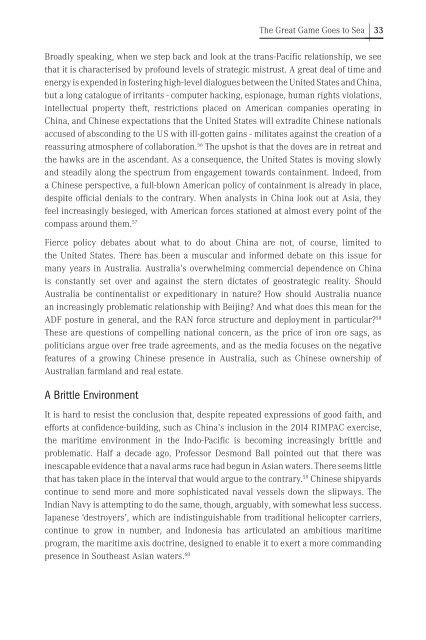THE FUTURE OF SEA POWER
SPC2015_Proceedings
SPC2015_Proceedings
Create successful ePaper yourself
Turn your PDF publications into a flip-book with our unique Google optimized e-Paper software.
The Great Game Goes to Sea | 33<br />
Broadly speaking, when we step back and look at the trans-Pacific relationship, we see<br />
that it is characterised by profound levels of strategic mistrust. A great deal of time and<br />
energy is expended in fostering high-level dialogues between the United States and China,<br />
but a long catalogue of irritants - computer hacking, espionage, human rights violations,<br />
intellectual property theft, restrictions placed on American companies operating in<br />
China, and Chinese expectations that the United States will extradite Chinese nationals<br />
accused of absconding to the US with ill-gotten gains - militates against the creation of a<br />
reassuring atmosphere of collaboration. 56 The upshot is that the doves are in retreat and<br />
the hawks are in the ascendant. As a consequence, the United States is moving slowly<br />
and steadily along the spectrum from engagement towards containment. Indeed, from<br />
a Chinese perspective, a full-blown American policy of containment is already in place,<br />
despite official denials to the contrary. When analysts in China look out at Asia, they<br />
feel increasingly besieged, with American forces stationed at almost every point of the<br />
compass around them. 57<br />
Fierce policy debates about what to do about China are not, of course, limited to<br />
the United States. There has been a muscular and informed debate on this issue for<br />
many years in Australia. Australia’s overwhelming commercial dependence on China<br />
is constantly set over and against the stern dictates of geostrategic reality. Should<br />
Australia be continentalist or expeditionary in nature? How should Australia nuance<br />
an increasingly problematic relationship with Beijing? And what does this mean for the<br />
ADF posture in general, and the RAN force structure and deployment in particular? 58<br />
These are questions of compelling national concern, as the price of iron ore sags, as<br />
politicians argue over free trade agreements, and as the media focuses on the negative<br />
features of a growing Chinese presence in Australia, such as Chinese ownership of<br />
Australian farmland and real estate.<br />
A Brittle Environment<br />
It is hard to resist the conclusion that, despite repeated expressions of good faith, and<br />
efforts at confidence-building, such as China’s inclusion in the 2014 RIMPAC exercise,<br />
the maritime environment in the Indo-Pacific is becoming increasingly brittle and<br />
problematic. Half a decade ago, Professor Desmond Ball pointed out that there was<br />
inescapable evidence that a naval arms race had begun in Asian waters. There seems little<br />
that has taken place in the interval that would argue to the contrary. 59 Chinese shipyards<br />
continue to send more and more sophisticated naval vessels down the slipways. The<br />
Indian Navy is attempting to do the same, though, arguably, with somewhat less success.<br />
Japanese ‘destroyers’, which are indistinguishable from traditional helicopter carriers,<br />
continue to grow in number, and Indonesia has articulated an ambitious maritime<br />
program, the maritime axis doctrine, designed to enable it to exert a more commanding<br />
presence in Southeast Asian waters. 60


